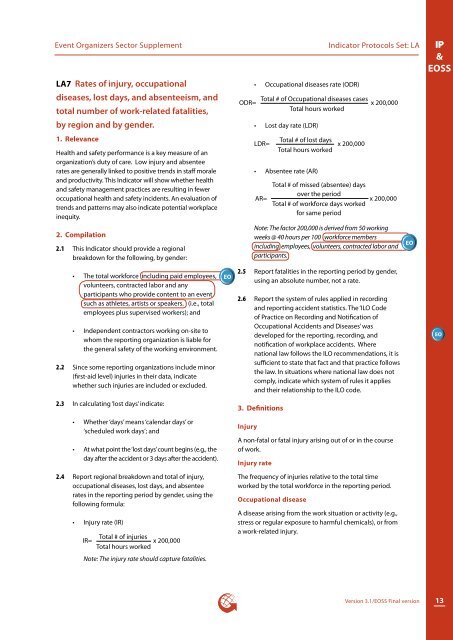Event Organizers Sector Supplement - Global Reporting Initiative
Event Organizers Sector Supplement - Global Reporting Initiative
Event Organizers Sector Supplement - Global Reporting Initiative
Create successful ePaper yourself
Turn your PDF publications into a flip-book with our unique Google optimized e-Paper software.
<strong>Event</strong> <strong>Organizers</strong> <strong>Sector</strong> <strong>Supplement</strong><br />
Indicator Protocols Set: LA<br />
IP<br />
&<br />
EOSS<br />
LA7 Rates of injury, occupational<br />
diseases, lost days, and absenteeism, and<br />
total number of work-related fatalities,<br />
by region and by gender.<br />
• Occupational diseases rate (ODR)<br />
ODR= Total # of Occupational diseases cases x 200,000<br />
Total hours worked<br />
• Lost day rate (LDR)<br />
1. Relevance<br />
Health and safety performance is a key measure of an<br />
organization’s duty of care. Low injury and absentee<br />
rates are generally linked to positive trends in staff morale<br />
and productivity. This Indicator will show whether health<br />
and safety management practices are resulting in fewer<br />
occupational health and safety incidents. An evaluation of<br />
trends and patterns may also indicate potential workplace<br />
inequity.<br />
LDR=<br />
Total # of lost days<br />
Total hours worked<br />
x 200,000<br />
• Absentee rate (AR)<br />
Total # of missed (absentee) days<br />
over the period<br />
AR= x 200,000<br />
Total # of workforce days worked<br />
for same period<br />
2. Compilation<br />
2.1 This Indicator should provide a regional<br />
breakdown for the following, by gender:<br />
Note: The factor 200,000 is derived from 50 working<br />
weeks @ 40 hours per 100 workforce members<br />
including employees, volunteers, contracted labor and<br />
participants.<br />
EO<br />
• The total workforce including paid employees,<br />
volunteers, contracted labor and any<br />
participants who provide content to an event<br />
such as athletes, artists or speakers. (i.e., total<br />
employees plus supervised workers); and<br />
• Independent contractors working on-site to<br />
whom the reporting organization is liable for<br />
the general safety of the working environment.<br />
2.2 Since some reporting organizations include minor<br />
(first-aid level) injuries in their data, indicate<br />
whether such injuries are included or excluded.<br />
EO<br />
2.5 Report fatalities in the reporting period by gender,<br />
using an absolute number, not a rate.<br />
2.6 Report the system of rules applied in recording<br />
and reporting accident statistics. The ‘ILO Code<br />
of Practice on Recording and Notification of<br />
Occupational Accidents and Diseases’ was<br />
developed for the reporting, recording, and<br />
notification of workplace accidents. Where<br />
national law follows the ILO recommendations, it is<br />
sufficient to state that fact and that practice follows<br />
the law. In situations where national law does not<br />
comply, indicate which system of rules it applies<br />
and their relationship to the ILO code.<br />
EO<br />
2.3 In calculating ‘lost days’ indicate:<br />
3. Definitions<br />
• Whether ‘days’ means ‘calendar days’ or<br />
‘scheduled work days’; and<br />
• At what point the ‘lost days’ count begins (e.g., the<br />
day after the accident or 3 days after the accident).<br />
Injury<br />
A non-fatal or fatal injury arising out of or in the course<br />
of work.<br />
Injury rate<br />
2.4 Report regional breakdown and total of injury,<br />
occupational diseases, lost days, and absentee<br />
rates in the reporting period by gender, using the<br />
following formula:<br />
• Injury rate (IR)<br />
Total # of injuries<br />
IR=<br />
x 200,000<br />
Total hours worked<br />
Note: The injury rate should capture fatalities.<br />
The frequency of injuries relative to the total time<br />
worked by the total workforce in the reporting period.<br />
Occupational disease<br />
A disease arising from the work situation or activity (e.g.,<br />
stress or regular exposure to harmful chemicals), or from<br />
a work-related injury.<br />
Version 3.1/EOSS Final version<br />
13

















